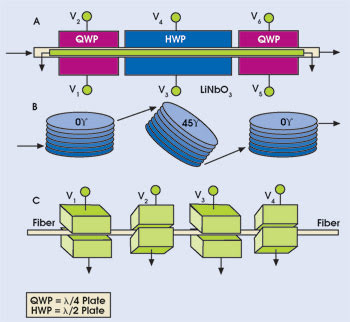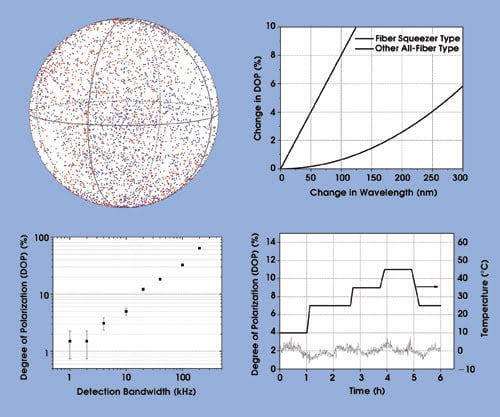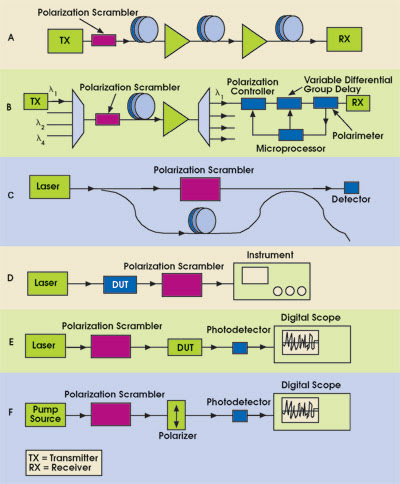Higher bit rates are making the polarization property of light an important factor in the design of high-speed optical communications networks.
Steve Yao, Yongqiang Shi and Jianwei Ma
Polarization is a fundamental property of light. In classical physics, light is modeled as a
sinusoidal electromagnetic wave in which an oscillating electric field and an oscillating
magnetic field propagate through space. Polarization is defined in terms of the
pattern traced out in the transverse plane by the electric field vector as a function
of time.
For unpolarized light, the plane of polarization
fluctuates randomly around the direction of light beam propagation. Therefore, on
average, no direction is favored. The rate of fluctuation is so fast that an “observer”
or a detector cannot tell the state of polarization at any given instant. Natural
light (sunlight, firelight) is unpolarized. Otherwise, the light beam is partially
or fully polarized. The degree of polarization describes how much total light intensity
is polarized. For instance, it equates to 100 percent for totally polarized light
and zero for completely unpolarized light. Most high-performance lasers used in
long-haul communications systems involve polarized light sources.
As the bit rate increases, fiber optic
communications systems become increasingly sensitive to polarization-related impairments.
Problems can arise related to polarization mode dispersion in optical fibers, polarization-dependent
loss in passive optical components, polarization-dependent modulation in electro-optic
modulators, polarization-dependent gain in optical amplifiers, polarization-dependent
center wavelength in wavelength division multiplexing (WDM) filters, polarization-dependent
response in receivers, and polarization-dependent sensitivity in sensors and coherent
communications systems.
Scrambling principles
Polarization scrambling can help mitigate many
of these issues. Scrambling occurs when the state of polarization of totally polarized
light will vary randomly at a relatively low rate. Although the state is well-defined
and the degree of polarization close to 100 percent at any instant, on a time average,
the degree of polarization will approach zero. Therefore, the degree of polarization
for scrambled light depends on the average time or the detection bandwidth of the
observer.
A polarization scrambler actively changes
the state of polarization using the polarization modulation method. Scramblers based
on different technologies are available today, including LiNbO3, resonant fiber-coil-
and fiber-squeezer-based systems.
LiNbO3 scramblers use the electro-optic
effect to modulate the state of polarization. For example, a phase modulator can
work as a scrambler when the input state is linearly polarized 45° with respect
to the applied modulation electric field. There will be a trade-off for the resulting
high speed, though — in the forms of high insertion loss, polarization-dependent
loss, residual amplitude modulation (activation loss), sensitivity to input polarization
state, and cost — because a waveguide must be inserted in the fiber line.
Multiple modulation sections with different electric field directions may help make
the device less polarization-sensitive, but this is often at the expense of increased
complexity and additional cost (Figure 1).

Figure 1. Types of polarization scramblers include devices based on LiNbO3 (A), on fiber
resonant coils (B) and on fiber squeezers (C).
A device based on a resonant fiber
coil is constructed by winding fiber around an expandable piezoelectric cylinder.
An applied electric field causes the cylinder to expand, which in turn induces birefringence
in the fiber via the photoelastic effect. If the frequency of the electric field
is in resonance with the piezoelectric cylinder, the induced birefringence will
be large enough to cause sufficient polarization modulation with a relatively low
applied voltage.
In practice, it is possible to cascade
multiple fiber cylinders with different orientations to reduce polarization sensitivity.
Compared with LiNbO3 scramblers, this alternative has the advantages of low insertion
loss, polarization-dependent loss and cost. On the other hand, it suffers from large
size, low scrambling speed and large residual phase modulation as a result of significant
fiber stretching when the fiber coil expands.
Squeezing fiber can induce enough birefringence
to cause large polarization modulation if the input polarization is 45° from
the squeezing axis. One way to make a polarization-insensitive scrambler is to cascade
several fiber squeezers oriented 45° from each other (Figure 2). The device
can operate resonantly at higher scrambling frequencies or nonresonantly at lower
frequencies.

Figure 2. A polarization scrambler made with fiber squeezers is suitable
for applications such as network equipment, fiber sensor systems, and test and measurement
instruments.
Compared with the LiNbO3 scrambler,
the device has the benefit of low insertion loss, polarization-dependent loss and
cost. Compared with the fiber coil scrambler, it offers scrambling flexibility and
small size. In addition, it has an edge over both in terms of low residual phase
modulation and residual amplitude modulation. Low residual phase modulation is important
for avoiding interference-related noise, and low residual amplitude modulation is
critical for using the scrambler for polarization-dependent loss and degree-of-polarization
measurement of optical devices.
Engineers generally characterize a
scrambler’s performance based on the degree of polarization of the scrambled
light over a certain period of time and on the uniformity of the state-of-polarization
Poincaré sphere coverage (Figure 3). In practice, the wavelength and temperature
sensitivities of the scrambler’s performance also are important for real-world
applications.

Figure 3. A multistage fiber squeezer scrambler is much less sensitive to wavelength and
temperature changes than are its alternatives. Scrambling uniformity also is excellent,
as shown on the Poincaré sphere developed for the scrambler board.
Operational lifetime is always an important
consideration in industrial applications. Some users may question the lifetime of
the fiber under stress in the fiber squeezers. Indeed, without proper treatment
and protection, the fiber may break in a short time. Since 1996, General Photonics
has put a great deal of effort into finding fiber failure mechanisms and corresponding
methods for protection. Based on a proprietary and patented fiber protection recipe,
fiber in a typical squeezer under maximum operational stress has an estimated mean
time to failure of 2 billion years. Such a result is not surprising, considering
that the stress in a polarization-maintaining fiber induced by the two stress rods
is on the same order of magnitude as the stress applied to the fiber by the fiber
squeezer. In continued endurance tests, fiber squeezers have passed 1 trillion (1012)
activation cycles, and the number is expected to rise as the tests continue.
End users have access to a variety
of polarization scramblers from several manufacturers. Examples include a stand-alone
desktop instrument from ILX Lightwave Corp. of Bozeman, Mont.; a plug-in module
from Exfo of Vanier, Quebec, Canada, that is part of a mainframe test instrument;
and board-level scramblers designed for low-cost systems and OEM applications from
General Photonics. These scramblers have their own intended market and their own
advantages. Which type is most suitable for a particular user depends on the application,
user preference and budget.
It also is possible to classify scramblers
according to their driving frequency. To obtain the best result, the squeezers should
not be set at the harmonic or subharmonic of each other. For some scramblers, the
frequencies are factory-set and cannot be changed; therefore, their scrambling rate
is fixed. To produce the highest possible scrambling rate, such devices generally
rely on the resonant nature of the piezoelectric transducers.
Alternatively, scramblers can be constructed
with user-selectable scrambling rates. An example is a fiber-squeezer-based miniature
scrambler designed for handheld and field instruments. Its scrambling rate can be
changed in increments from a few hertz to a few tens of kilohertz using either a
switch or a computer command.
Applications
Polarization scramblers have numerous applications
in optical communications networks, fiber sensor systems, and test and measurement
systems (Figure 4). One example is to use the device at the transmitter side to
minimize polarization-dependent gain or polarization hole burning of erbium-doped
fiber amplifiers in ultralong-haul systems. For this application, the scrambling
rate should be significantly faster than the inverse of the gain recovery time constant
of the fiber amplifiers (on the order of 10 kHz).

Figure 4. A scrambler can be used at the transmitter side to minimize polarization-dependent gain or polarization
hole burning of erbium-doped fiber amplifiers in ultralong-haul systems (A). It
can also assist in monitoringpolarization mode dispersion in a WDM system (B), the
elimination of the polarization fading of a fiber sensor (C), the effective elimination
of polarization of an instrument such as a diffraction-grating-based optical spectrum
analyzer (D), polarization-dependent loss measurement for a device under test (DUT)
(E), and pump degree of polarization when combined with a digital scope (F).
Scramblers can also assist in the monitoring
of polarization mode dispersion in a WDM system. Generally speaking, this involves
measuring the degree of polarization of the optical data stream propagated through
the fiber. A small value usually indicates a large polarization mode dispersion
effect. However, such a measurement may be erroneous if the input state of polarization
to the transmission fiber is substantially aligned with its principal state of polarization.
For such a situation, the measured
degree of polarization is always large, no matter how large the differential group
delay between the two principal states of polarization. A scrambler at the transmitter
side can be used to effectively eliminate such an anomaly. Furthermore, it enables
a polarimeter in the polarization mode dispersion compensator at the receiver side
to identify the principal state of polarization, which in turn speeds up compensation.
Signal-to-noise-ratio monitoring of WDM channels also is possible with a polarizer
placed after a scrambler.
Eliminating fading
Another application uses scramblers to eliminate
the polarization fading of a fiber sensor. In such a system, the envelope of the
response curve is independent of the polarization fluctuation.
Placing a scrambler in front of a polarization-sensitive
instrument, such as a diffraction-grating-based optical spectrum analyzer, can also
effectively eliminate its polarization dependence if the scrambling rate is sufficiently
faster than the detector speed in the instrument. In addition, the device can help
to measure the polarization-dependent loss (PDL) of a device under test with the
help of a digital scope. The resulting loss can be calculated as:
PDL = 10log (Vmax/Vmin)
where Vmax and Vmin are the maximum and minimum signals displayed by the digital scope.
Raman amplifiers generally exhibit
strong polarization-dependent gain if the pump laser is highly polarized. Minimizing
gain requires the use of a depolarized pump source. The degree of polarization of
the pump source directly relates to the polarization-dependent gain of the amplifier
and therefore must be carefully characterized.
It also is possible to use scramblers
to accurately measure the degree of polarization (DOP) with the use of a digital
scope. The degree of polarization of the light source is calculated using the following
formula:
DOP = (Vmax — Vmin)/(Vmax + Vmin)
In summary, a polarization scrambler
is an important device for fiber optic communications, fiber sensors, and fiber
optic test and measurement applications.
Meet the authors
Steve Yao is chief technology officer at General
Photonics Corp. in Chino, Calif.
Yongqiang Shi is the chief scientist,
and Jianwei Ma is a senior applications engineer at the company.